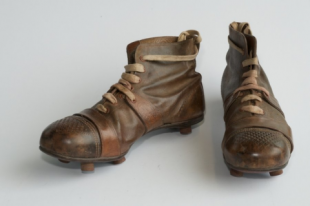At a gathering in New Jersey in 1995 of some people connected to the National Soccer Hall of Fame, mostly former players from the 1940 and ’50s, a man named Emil Schillinger was asked to make a few remarks. I thought he was going to get up, say 20 seconds or so of thanks to the host and return to his seat. Instead, he stood and talked for 40 minutes, interestingly and fascinatingly, about the work he’d done and how it related to the positions he’d filled with the Philadelphia Americans of the American Soccer League and the league itself. The group of us, about 15 people, sat there enthralled.
The particularly noteworthy thing about this occurrence is that Emil Schillinger was 97 years old at the time. I can guarantee you that I’d never heard someone that age give a 40-minute speech before.
The first time I met Emil Schillinger, he was already in his 90s. I was doing some research about U.S. national team games from decades ago, and about the clubs that players were with at the time of particular games. I was told that Schillinger was someone I should see. He lived on Montour Street in Northeast Philadelphia, just a few miles from me, so I called him and visited him. He had volumes of exactly the sort of information I was seeking. Soon after that, I started to see him several times a year at Hall of Fame events. And I learned that Schillinger, who was elected to the Hall of Fame in 1960, was quite well established as The Grand Old Man of Philadelphia Soccer.
Emil Schillinger first came to the fore in American soccer in 1938, when he was named manager of the Philadelphia German-Americans of the American Soccer League, succeeding Elmer Schroeder, whose protege he was. Schillinger had been involved with the club since its founding in the 1920s by the Philadelphia German Rifle Club, and at the time of his elevation to manager, he was the team’s business manager. The German-Americans (who changed their name to the Philadelphia Americans in 1941), were already among the leading American soccer teams. They had won the U.S. Open Cup in 1936, defeating the St. Louis Shamrocks in the final. In 1935, they had won the American Soccer League championship, outdistancing the second-place New York Americans by 37 points to 28. Before turning professional, they had won the National Amateur Cup in 1933 and 1934.
When Schillinger took over managing the Philadelphia German-Americans, the American Soccer League was in the midst of a period of domination by the Scots-Americans of Kearny, N.J. The Kearny Scots won the ASL title five years in a row, from 1937 to 1941. The Philadelphia Americans finally broke that string in the 1941-42 season, edging Brookhattan of New York by 24-22 in the final standings.
That victory was the beginning of a pretty good run for Schillinger’s team. The Americans won further ASL titles in 1944, 1947, 1948 and 1952. Perhaps the most satisfying of those was the 1951-52 victory , when the Americans finished one point ahead of the rival Philadelphia Nationals, and ended the Nationals’ run of consecutive ASL titles at three. (That was part of a golden era for Philadelphia soccer. In the 23 seasons between 1942 and 1964, Philadelphia teams won the ASL title 15 times).
The Americans of the 1930s had had some great players, such as future Hall of Famers Hun Ryan and Al Harker, but under Schillinger the franchise developed a new crop of stars. The leaders of this crowd were defender Werner Mieth, midfielder Lefty Mervine and forwards Jukey Nanoski and Bob Gormley. Mervine was chosen as the ASL’s most valuable player in the 1946-47 season, and Nanoski twice was the ASL’s leading scorer.
In addition to his managing duties, Emil Schillinger also served as president of the ASL from 1942 to 1945. During that time, he helped the league to struggle through World War II, when well over 100 of its players were in the armed forces rather than on the soccer field. Six of those players never returned from the war, including one of Schillinger’s Philadelphia Americans stars, Walt Patykula.
Emil Schillinger lived to be 101. The last time that I saw him was at his 100th birthday party, in 1998. Among people involved with the National Soccer Hall of Fame 15 years ago, Emil Schillinger was legendary. There aren’t many downsides to the growth of American soccer, but one of the few that do exist is the way that some legends of decades past have been upstaged by more recent events. Emil Schillinger, who was not a famous player, is one legend who, sadly, has begun to fade. His name is a familiar one to generations of Philadelphia soccer fans, but not, I fear, to the many new fans that the game has generated here in the last few decades.


Thanks for the story, Roger. I’d like a paraphrase of the forty minute speech.
Roger:
Lefty Mervine was my father in-law and I’m trying to find out what jersey number he wore. Would u have any pictures of him showing his jersey number?
Thanks
Jim Kerrigan
Jkerrigan111@comcast.net